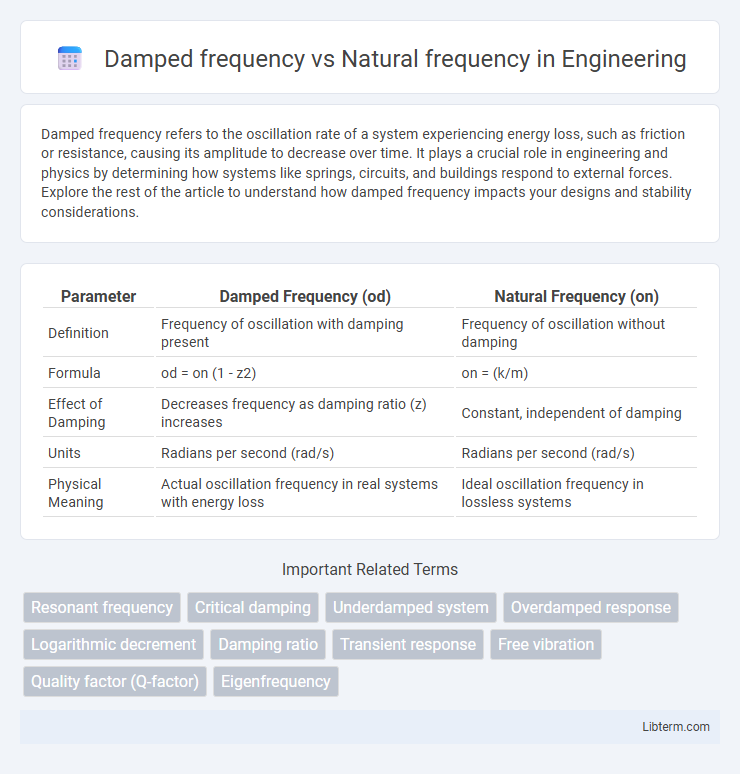Damped frequency refers to the oscillation rate of a system experiencing energy loss, such as friction or resistance, causing its amplitude to decrease over time. It plays a crucial role in engineering and physics by determining how systems like springs, circuits, and buildings respond to external forces. Explore the rest of the article to understand how damped frequency impacts your designs and stability considerations.
Table of Comparison
| Parameter | Damped Frequency (od) | Natural Frequency (on) |
|---|---|---|
| Definition | Frequency of oscillation with damping present | Frequency of oscillation without damping |
| Formula | od = on (1 - z2) | on = (k/m) |
| Effect of Damping | Decreases frequency as damping ratio (z) increases | Constant, independent of damping |
| Units | Radians per second (rad/s) | Radians per second (rad/s) |
| Physical Meaning | Actual oscillation frequency in real systems with energy loss | Ideal oscillation frequency in lossless systems |
Introduction to Damped and Natural Frequencies
Natural frequency refers to the inherent rate at which a system oscillates when disturbed without any external force or energy loss. Damped frequency is the reduced oscillation rate experienced by the system due to the presence of damping forces that dissipate energy. The relationship between these frequencies is critical in understanding vibration behavior in mechanical, structural, and electrical systems.
Understanding Natural Frequency
Natural frequency is the inherent rate at which a system oscillates when disturbed from its equilibrium position without any external force or damping influences. It depends primarily on the system's mass and stiffness, defining the baseline oscillatory behavior for structures, mechanical components, or electrical circuits. Understanding natural frequency allows for predicting resonance conditions where external forces match this frequency, potentially causing excessive vibrations or system failure.
Defining Damped Frequency
Damped frequency refers to the oscillation rate of a system experiencing energy loss due to damping forces, resulting in a frequency lower than the natural frequency of the undamped system. It is calculated as the natural frequency multiplied by the square root of one minus the damping ratio squared, indicating the system's response under light or moderate damping conditions. Understanding damped frequency is essential for analyzing the dynamic behavior of mechanical and electrical oscillatory systems subjected to resistive forces.
Mathematical Relationship Between Damped and Natural Frequencies
The damped frequency \( \omega_d \) is mathematically related to the natural frequency \( \omega_n \) by the equation \( \omega_d = \omega_n \sqrt{1 - \zeta^2} \), where \( \zeta \) represents the damping ratio. This relationship shows that the damped frequency decreases as the damping ratio increases, approaching zero when the system transitions to critical damping (\( \zeta = 1 \)). For underdamped systems (\( 0 < \zeta < 1 \)), \( \omega_d \) remains real and less than \( \omega_n \), reflecting oscillations at a lower frequency due to energy dissipation.
Factors Influencing Damping in Oscillatory Systems
Damped frequency is lower than the natural frequency due to energy loss in oscillatory systems, primarily influenced by factors such as material internal friction, air resistance, and mechanical joint friction. The damping coefficient and mass directly affect the reduction in oscillation amplitude and frequency shift, where higher damping leads to a more significant decrease in damped frequency relative to natural frequency. Environmental conditions and system design parameters also play critical roles in determining the extent of damping and the resulting oscillatory behavior.
Effects of Damping on System Response
Damping reduces the amplitude of oscillations and lowers the damped frequency compared to the natural frequency in dynamic systems. The presence of damping causes the system to lose energy over time, resulting in a gradual decrease in vibration amplitude and a shift from the natural frequency to a lower damped frequency. This effect improves stability and prevents resonance, mitigating excessive oscillations that could lead to mechanical failure.
Graphical Representation: Damped vs Natural Frequency
The graphical representation of damped frequency versus natural frequency illustrates how the oscillation rate decreases as damping increases, resulting in a damped frequency that is always less than the natural frequency. On a frequency response graph, the damped frequency curve shifts downward and to the right compared to the natural frequency's peak, demonstrating energy loss in the system. This distinction is crucial for understanding the behavior of underdamped mechanical or electrical oscillators in real-world applications.
Real-World Examples of Damped and Natural Frequencies
The natural frequency of a system represents the rate at which it oscillates without external forces, commonly observed in structures like bridges or guitar strings vibrating at their inherent frequency. Damped frequency occurs when energy dissipation, such as friction or air resistance, reduces oscillation speed, evident in automotive shock absorbers that control suspension vibrations for smoother rides. Real-world examples include skyscrapers designed with tuned mass dampers to mitigate wind-induced sway, where the damped frequency lowers the natural frequency to enhance stability and occupant comfort.
Importance in Engineering and Design Applications
Damped frequency plays a crucial role in engineering and design applications by reflecting the actual oscillation rate of systems subjected to energy dissipation, which differs from the natural frequency representing ideal, undamped vibrations. Accurately accounting for damped frequency ensures the structural integrity and dynamic stability of mechanical systems, such as bridges, automotive suspensions, and aerospace components, by preventing resonance-induced failures. Engineers use this parameter to optimize vibration isolation, control system responsiveness, and enhance durability under real operating conditions.
Key Differences and Practical Implications
Damped frequency is the oscillation frequency of a system under the effect of damping, always lower than the natural frequency, which is the frequency of oscillation without damping. The key difference lies in energy dissipation: natural frequency assumes an ideal, undamped system, while damped frequency accounts for real-world energy loss, influencing the amplitude and phase of vibrations. Practically, engineers use damped frequency to design systems that minimize resonance risks and ensure stability, especially in mechanical and structural engineering applications.
Damped frequency Infographic

 libterm.com
libterm.com